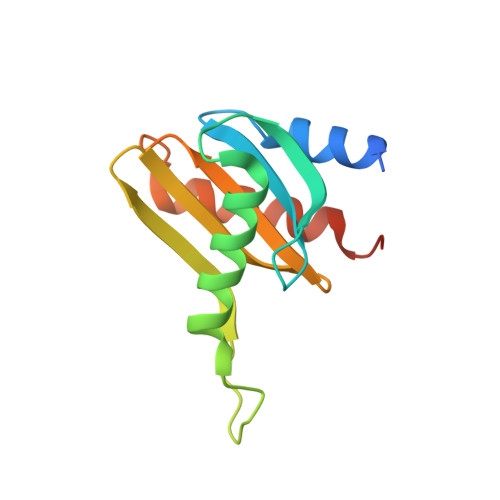The structure of the MAP kinase scaffold MP1 bound to its partner p14: a complex with a critical role in endosomal MAP kinase signaling
Lunin, V.V., Munger, C., Wagner, J., Ye, Z., Cygler, M., Sacher, M.(2004) J Biol Chem 279: 23422-23430
- PubMed: 15016825
- DOI: https://doi.org/10.1074/jbc.M401648200
- Primary Citation of Related Structures:
1SKO - PubMed Abstract:
Scaffold proteins of the mitogen-activated protein kinase (MAPK) pathway have been proposed to form an active signaling module and enhance the specificity of the transduced signal. Here, we report a 2-A resolution structure of the MAPK scaffold protein MP1 in a complex with its partner protein, p14, that localizes the complex to late endosomes. The structures of these two proteins are remarkably similar, with a five-stranded beta-sheet flanked on either side by a total of three helices. The proteins form a heterodimer in solution and interact mainly through the edge beta-strand in each protein to generate a 10-stranded beta-sheet core. Both proteins also share structural similarity with the amino-terminal regulatory domains of the membrane trafficking proteins, sec22b and Ykt6p, as well as with sedlin (a component of a Golgi-associated membrane-trafficking complex) and the sigma2 and amino-terminal portion of the mu2 subunits of the clathrin adaptor complex AP2. Because neither MP1 nor p14 have been implicated in membrane traffic, we propose that the similar protein folds allow these relatively small proteins to be involved in multiple and simultaneous protein-protein interactions. Mapping of highly conserved, surface-exposed residues on MP1 and p14 provided insight into the potential sites of binding of the signaling kinases MEK1 and ERK1 to this complex, as well as the areas potentially involved in other protein-protein interactions.
Organizational Affiliation:
Biotechnology Research Institute, National Research Council of Canada, Montréal, Québec H4P 2R2, Canada.















